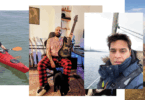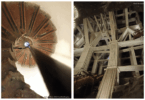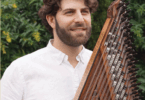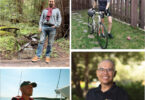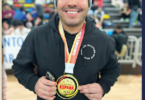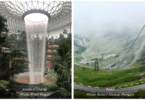byRoberto Cimadevilla Gonzalez, ZIV, Spain
Due to the great relationship that all sliding sports have with each other I have practiced several of them. In this article I will talk about water-skiing, surfing and alpine skiing, which are the main sports I play.
Water Skiing
The Beginning: I started water skiing when I was 7 years old in Benidorm´s cable-ski, which is the first commercial cable-ski in the world. My parents used to spend the summer holidays there and they decided that the whole family started water skiing, which was more fun than starting just my sister and I alone.
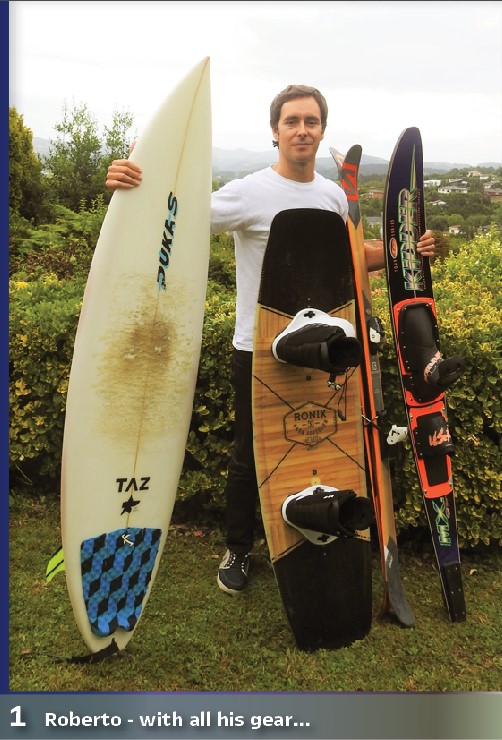
When I started water skiing the main disciplines were slalom and trick ski. Then, in the nineties, wakeboarding arrived. I mainly focused on the slalom discipline, competing until I was 19 years old. At the age of 17 I won first place in the cable-ski Spanish championship in the junior category! And when I was 18 I got 5th place in the senior category! In 2016, the Benidorm cable-ski celebrated its 50th anniversary and the wakeboard and slalom Spanish championship took place in this cable-ski at the same time. I was convinced, after 20 years without competing, by some friends, to participate again in the slalom discipline (which is now referred to as a “classical discipline,” which tells me that I am getting older) and, luckily, I got third place in open category!
In parallel to slalom ski I also did trick ski. Now I am doing more wakeboarding because, since last year, I have a wake park very close to my home.
How does it work? In cable water skiing the skier is not pulled by a boat but by an overhead cable, suspended at some meters above the water surface by several towers. The cable is passed in each tower through a pulley. One of them is rotated by a motor (normally an electric one), which makes the cable move. The cable includes a number of carriers (depending on the length) that hook ropes to tow skiers. Ropes hook and unhook to the carriers without reducing the cable speed.
This system allows several riders to ski at the same time, which makes cable skiing more efficient than skiing behind a boat.
The disciplines I practiced the most are described below.
Slalom discipline: Slalom water skiing uses a monoski with feet facing forward, one in front of the other. The skier must go around the outside of 6 buoys, located at both sides of the cable, in a zig-zag pattern. The speed to do the first pass is chosen by the skier and if the six buoys are correctly taken, the speed in the next pass is increased by 3 km/h, until the maximum speed is reached (58 km/h for men between 15 and 35 years old and 55 km/h for the rest of the people). Once the 6 buoys are passed at the maximum speed, in the next pass the rope is shortened to make the reach of the buoys more difficult.
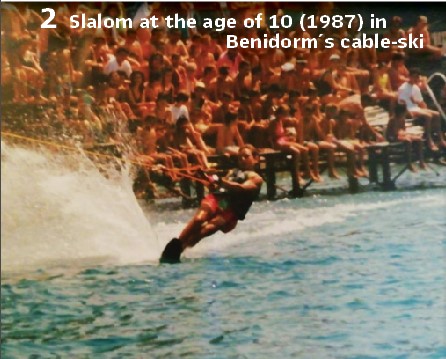
In a championship, the cable speeds up or the rope is shortened until the skier fails to complete the slalom course by falling or not getting around a buoy.
Note that the speed of 58 or 55 km/h is the cable one but due to the zig-zag done to pass around the buoys, the slalom skier experiences big accelerations and decelerations, reaching much higher speeds. For very short ropes the speed reached is higher than 100 km/h.
The equipment required consists of a monoski, a life jacket and, normally, gloves to grab the handle.
Wakeboarding uses a board with boots or bindings to attach both feet. Feet are located perpendicular to the movement direction, in a similar position to a skateboard, snowboard or surfing. Feet are normally a little bit angled and shoulder distance apart; they are located in a symmetrical position because most of the tricks can be done riding backwards (called “fakie” or “switch stance”).
Wakeboarding is normally done at 30 km/h.
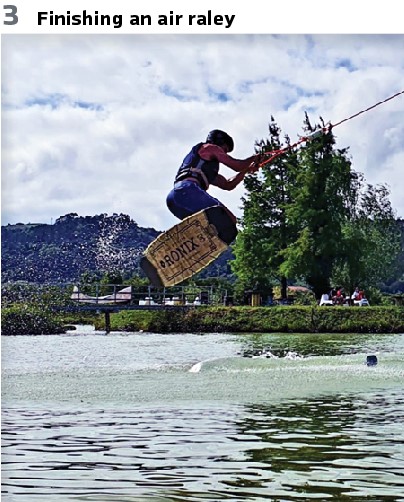
Cable wakeboarding, which is the discipline I usually practice, consists of doing tricks using different types of modules, such as kickers, which allow doing air tricks, or sliders, which permit sliding in different positions over them. It is also possible to do air tricks without kickers, by creating rope tension, leaning your body and edging the board. When the rope tension and edge is suddenly released, a catapult effect is generated by the cable to boost oneself in the air.
There is a high variety of wakeboard tricks:
- Spins can be performed surface, with ollie or with a kicker; they can be front side or back side and with heel side or toe side approach; the angle rotation in a spin can go from 90º until 720º or even more
- Inverts are air tricks where the position of the body is below the board: rolls (the board turns upside down from edge to edge), flips (the board turns upside down from tail to nose), raleys (the board is launched backwards making the rider be in a “superman” position)
- Slides are normally done over modules (“sliders”), with different parts of the board, and spinning during the slide itself and at the module exit
Any trick can be done in normal or switch stance.
The equipment required consists of a wakeboard, a life vest and a helmet.

What does it bring me? The feelings that water-ski provides me with are very intense, especially doing slalom.
This is because of the high speed you reach, the accelerations achieved by means of leaning your body and edging the ski and the decelerations you get during the turns.
With regard to wakeboarding, there is always a new trick to try, or you can do the same trick but with switch stance; therefore, you can always evolve. On the other hand, wake parks are all different from each other (they have different modules, different routes, etc), so it is quite fun to try new ones.
Both slalom and wakeboarding are very complete sports because they make you use almost every muscle in your body. They also improve your balance and coordination.
As a water sport it provides a calming effect, which helps you disconnect from dayly stress and worries.
How do I mix it with work? Fortunately, there is a wake park very close to my home so I can do wakeboarding almost the whole year. To do slalom I travel to other cable-skis such as the Benidorm´s one.
During a water ski session, I forget everything, so I can easily disconnect from work to start the next day with my batteries recharged.
There is a lot of technique behind water skiing, specially doing slalom at 55 km/h with shorter ropes or doing complex wakeboarding tricks. As an engineer I like understanding it very well watching videos. This helps you improve your performance.
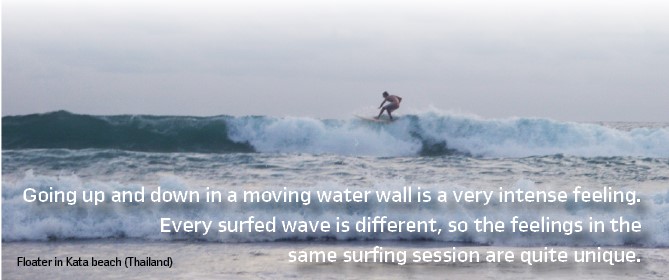
Surfing
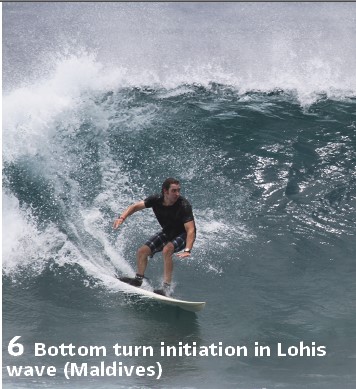
Start: Before starting to surf I did bodyboarding for 5 years. This helped me understand the ocean: the waves, the currents, the tides, the wave forecast (size and period of the waves, swell direction, wind speed and direction). When I was 20 I gave up bodyboarding and started surfing. I was studying engineering in Gijon, a city with very close surfing spots, so I took advantage to go surfing many days after classes.
How does it work? Surfing consists of riding a wave on its unbroken part, standing up on the surfboard. Surfing is normally done in the ocean, but it can also be done in pools with artificial waves. In fact, the headquarters of the company Wavegarden, one of the pioneers in the design of wave pools, are close to my home. In their R&D center they have their last wave pool model, which I had the pleasure to try.
For riding a wave, the surfer must paddle, lying down on the board, and stand up when the board is going down the wave. This is called the take-off. Once standing up, the surfer performs several turns in the bottom and upper parts of the wave.
When a surfer finishes riding a wave, he must return paddling to the waves breaking area. In order to pass broken waves, the surfer must dive deep enough to avoid being dragged by the wave energy. With short boards this is done with the so called “duck-dive.” The surfer must dive the board nose by pushing with the arms and then the board tail by pushing with one knee or foot. Good duck diving is very important if you want to surf medium to big size waves.
There are many surfing maneuvers. The main ones are:
- Bottom Turn: A turn at the bottom of the wave, it is used to set up other maneuvers done at the top of the wave
- Top turn: A turn at the top of the wave. There are different types of top turns, mainly depending on the wave position where they are done: re-entry, snap, off the lip, etc.
- Cutback: Changing the direction to go back to the breaking area, turning the board again when this area is reached, and continue surfing on the unbroken part
- Floater: Suspending the board at the top of a broken wave and going down
- Tube: Riding the hollow part of the wave, completely covered by the wave lip.
- Aerials: Getting in the air helped with the push generated by the wave lip
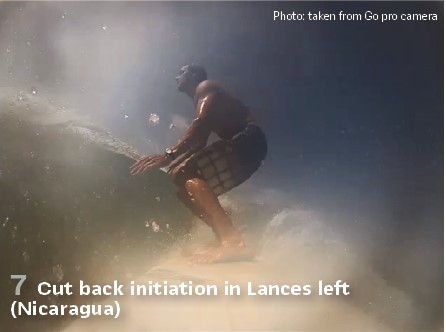
The equipment required consists of a surfboard with a leash to attach it to the rear foot. Obviously if the water is cold you will need a wetsuit, boats, gloves and a hood, depending on the water temperature. There are many different types of surfboards, depending on the type of waves (size, speed, shape). I currently use 5 different shortboards.
What does it bring me? Just the fact of being in the ocean, sitting on the surfboard, with glassy water (smooth water surface, best conditions for surfing) is very relaxing. Furthermore, going up and down in a moving water wall is a very intense feeling. On the other hand, every surfed wave is different, so the feelings in the same surfing session can be very varied.
Surfing is also quite a complete sport, especially for the upper body. It is also good for balance and coordination. Finally, travelling to new places to surf new waves is very exciting. I have done many trips focused on surfing: Hawaii, Indonesia, Maldives, Australia, New Zealand, Costa Rica, Nicaragua, Morocco, Barbados, Philippines, Portugal, France, Senegal, Brazil.
How do I Mix it with work? Fortunately, I live very close to surfing spots so I can go surfing afterwork or before it. I could also do some surfing during work trips like the ones I have done to Indonesia, Australia and Brazil.
As with water skiing, during a surfing session, I also forget everything, so I can easily disconnect from work and start the next day fresh.
Similarly, to water skiing, surfing is a very technical sport, so being an engineer, I like to understand the technique in detail, which makes you improve your performance.
Skiing
Start: I started skiing when I was 7 years old. My parents already skied so they took my sister and I to a ski resort in Andorra.
When I started skiing, skis were straight and long. The aim was learning how to do “wedeln,” a series of very fast short turns. The knees were quite closed. And the skis always skid. In the nineties “carving” arrived. This changed the way of skiing. And for the ones used to the “classical ski” it was hard to adapt to the new technique. Now I can combine both ways of skiing and carving has provided me with new feelings.

Since quite a young age I also started skiing off-piste. Furthermore, I also did some snowboarding.
How does it work? As everybody knows, alpine skiing consists of sliding down a snow-covered slope, doing turns to control the speed. Advanced skiers use two types of turns: carve turns and normal parallel turns.
Carve turns are done just by edging the skis. Carving skis have a parabolic shape, so they are narrower in the center. When a skier leans their feet, the skis will slightly bend, creating an arc shape that makes the ski turn. When doing carve turns the skis do not skid but they make clean traces in the snow; both the ski tip and tail follow the same path. Carving is the most efficient way to ski and it allows you not to lose speed. Therefore, it is very effective in competition.
Normal parallel turns are done making the skis skid, without waiting the skis to just turn by the arc shape created by the edge. Parallel turns are required in steep slopes or slopes with bumps.
The equipment required consists of skis, boots, sticks, glasses and winter clothes.
What does it bring me? The strongest feelings I experience skiing are over powder snow or when carving. Skiing on powder snow is like floating over cotton wool. Carving you can feel the centrifugal force (higher the faster you go), that allows leaning your body, and the grip that the ski edges gives you.
On the other hand, just the fact of being in the mountain, watching the beautiful scenery and breathing fresh air is very pleasant.
Finally, ski strengthens the lower body and improves cardio.
How do I mix it with work? Small Ski areas are located approximately 2 hours from my home. To reach bigger ones you need 3 to 4 hours. Therefore, I practice skiing during the weekends in winter time. As the other sports, ski also requires a lot of technique. I like studying it to improve my performance.
Biography:
Roberto Cimadevilla graduated in Electrical Engineering from the Higher School of Engineering of Gijón, Spain in 2001. He did his final year project at the University of Dundee, Scotland, and obtained a master´s degree in “Analysis, simulation and management of electrical power systems” at the University of País Vasco, Spain. He started his professional career in the protection maintenance area of Red Eléctrica de España (Spanish TSO). Roberto joined ZIV in 2003, where he actively participated in the development of several protection and control devices, including distance, transformer differential, line differential and feeder relays. Roberto has held several positions of technical and management responsibility inside ZIV. He is currently the Manager of the Application Engineering Department of the T&D Product Line. Roberto has written more than 25 papers, he is an IEEE member and has participated in several CIGRE working groups.



